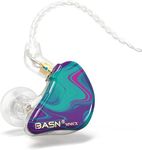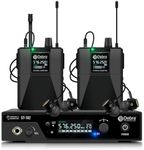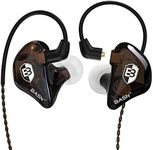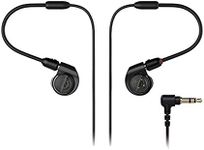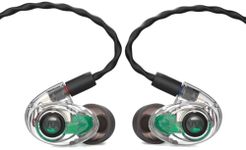Buying Guide for the Best In Ear Monitors
In-ear monitors (IEMs) are a popular choice for both professional musicians and everyday listeners who want high-quality sound in a compact form. They fit snugly inside your ear canal, providing excellent noise isolation and a more immersive listening experience. When choosing the right IEMs, it's important to consider several key specifications that will affect sound quality, comfort, and usability. Understanding these specs will help you find a pair that suits your listening preferences and lifestyle.Driver TypeThe driver is the component that converts electrical signals into sound. In IEMs, common driver types include dynamic, balanced armature, and hybrid. Dynamic drivers are known for their robust bass and are generally more affordable. Balanced armature drivers offer more detail and clarity, especially in the mid and high frequencies, but may lack in bass. Hybrid drivers combine both types to provide a balanced sound profile. Choose dynamic drivers if you prefer bass-heavy music, balanced armature for clarity and detail, or hybrid for a well-rounded sound.
Frequency ResponseFrequency response indicates the range of sound frequencies an IEM can reproduce, typically measured in Hertz (Hz). A wider frequency response range means the IEM can produce deeper bass and higher treble. However, the human ear can only hear from about 20 Hz to 20 kHz, so values beyond this range may not be perceptible. If you enjoy bass-heavy music, look for IEMs with a lower frequency range starting point. For classical or vocal music, a wider range can provide more detail and clarity.
ImpedanceImpedance, measured in ohms, refers to the resistance an IEM offers to the electrical signal. Lower impedance (16-32 ohms) is suitable for use with smartphones and portable devices, as it requires less power to produce high audio levels. Higher impedance IEMs (above 32 ohms) may require an external amplifier to reach optimal performance. If you plan to use your IEMs with a smartphone or portable player, opt for lower impedance. For use with professional audio equipment, higher impedance may be preferable.
SensitivitySensitivity, measured in decibels (dB), indicates how loud the IEMs will be at a given power level. Higher sensitivity means the IEMs can produce more sound from less power, which is ideal for use with low-power devices like smartphones. Sensitivity typically ranges from 90 dB to 110 dB. If you often listen to music at lower volumes or use devices with limited power output, choose IEMs with higher sensitivity. For high-power audio equipment, sensitivity is less of a concern.
Fit and ComfortFit and comfort are crucial for IEMs, as they need to sit securely in your ear canal for optimal sound quality and noise isolation. IEMs come with various ear tip sizes and materials, such as silicone or foam, to ensure a good fit. A proper fit not only enhances sound quality but also prevents discomfort during extended use. Consider trying different ear tip sizes and materials to find the most comfortable and secure fit for your ears, especially if you plan to wear them for long periods.
Cable TypeThe cable type can affect both the durability and convenience of your IEMs. Some IEMs come with detachable cables, which allow for easy replacement if the cable gets damaged. Others have fixed cables, which may be less convenient but can be more affordable. Additionally, consider the cable's length and whether it has features like an in-line microphone or remote control. If you value durability and flexibility, opt for IEMs with detachable cables. For simplicity and cost-effectiveness, fixed cables may suffice.

